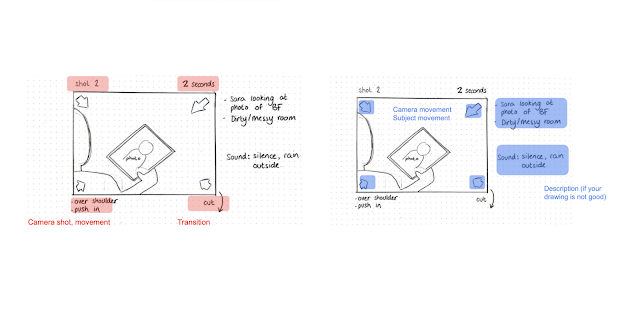Here is a summary of what we have been learning about in class. We learned about different types of Technical Elements (Camera, Sound, Mis-en-Scene, Editing) in Media, and creating StoryBoards.
・┆✦ Camera [◉°] ✦ ┆・
A camera captures images, and different shots and angles show emotion, size, and perspective.
Long Shot: Shows the full subject and setting.
Extreme Long Shot: Shows the subject from afar.
Medium Shot: Balances subject and setting, often used for conversations.
Cowboy Shot: Focuses on action, often used in Westerns.
Close up: Focuses on the face or details, shows emotion or importance.
Extreme Close up: Highlights tiny details and intensity.
POV: Shows a characters perspective, creates immersion.
Over the shoulders: Shows one character from another's viewpoint, creates connection or tension.
High Angle: Makes the subject appear weak or vulnerable.
Low Angle: Makes the subject appear powerful or dominant.
Dutch Angle: Creates unease or tension.
Establishing Shot: Provides location and context, often helps sets a scene.
Heres a video of what my teacher gave us to get a better understanding of camera angles:
Fixed | Camera remains static | Calm, peace, normal |
Push in | Camera moves slowly toward subject | Brings the audience closer, more involved, getting more serious. |
Pull out | Camera moves slowly away from subject | Takes audience away from the action, leaving a character. Detaching from subject |
Pan | Side to side, camera fixed | Reveal information, mirrors natural head movement of the audience. |
Tilt | Up and down, camera fixed | Same as pan, just a different direction |
Dolly | Camera moves around freely | More immersive, we are moving inside the subjects world, we feel part of the action |
Tracking | Camera moves around on tracks | Similar to dolly, but smoother. |
Crane | Taken by a camera mounted on a jib/crane that moves up and down. | Reveals the epic size of the setting, landscape. |
Handheld | Camera is shakey | Very natural, immersive. High energy |
Zoom | Zoom | Brings audience closer to budget. Draws our attention to something. |
Description | Effect | |
Diegetic sound | Sound that can be heard by the characters within the media text. | Add a sense of realism. Reveal information to characters (and then audience) |
Non diegetic sound | Sound that can only be heard by the audience. | Enhance meaning, create an emotional response in the audience |
Trans diegetic sound | Sound that transitions from one to the other. | Creates a link between the audience and the world. More immersive |
Description | Effect | |
Melodic | Positive and pleasing connotations | Enhances a positive scene. Create positive emotions in the audience. |
Discordant | Harsh and unpleasant connotations. | Enhance negative scenes. Create suspense, tension, anxiety |
Contrapuntal | Has an opposite tone to the on-screen visuals. | Adds deeper meaning to scenes. Insight into the character's thoughts. Maybe they seek pleasure in doing bad things. |
Continuity Editing | Non continuity editing |
*Match cut |
*Match cut |









No comments:
Post a Comment